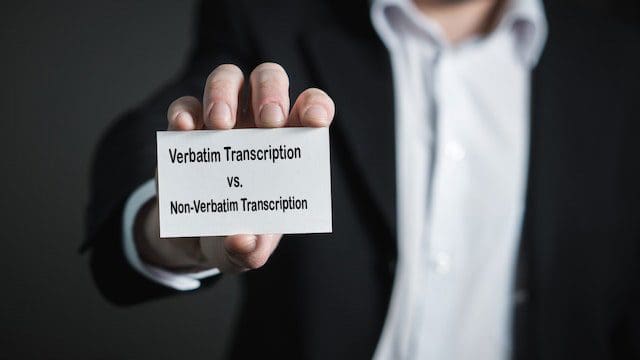Verbatim Transcription
Verbatim transcripts capture every word and sound, including filler words, stutters, and pauses, to produce a highly accurate and complete record of the original speech. Verbatim services are preferred when accuracy is critical. In technical industries like legal and medical contexts, even slight variations in the wording or tone can significantly impact the meaning of a statement. This level of detail is essential in situations where the accuracy of the transcript is critical, such as court proceedings or medical dictation.
Non-verbatim Transcription
Non-verbatim transcription involves editing the original speech to produce a more polished and readable transcript. This may involve omitting filler words, false starts, and repetitions, as well as correcting any grammatical errors. The transcripts can be more efficient and less costly, as experienced transcriptionists omit certain elements that may not be critical to the meaning of the speech. For example, in business contexts, non-verbatim transcripts can be edited to remove confidential information or to highlight key points. Moreover, there's space for greater customization, such as using formatting or bullet points to enhance the readability of the transcript.
In addition to verbatim and non-verbatim transcription, other types of transcription arise from the main types but are used interchangeably in the industry. Below are explanations for each:
1. Intelligent Verbatim
Intelligent verbatim, also known as clean verbatim, is a type of transcription that involves removing unnecessary elements from the speech, such as filler words, stutters, and false starts while retaining the meaning and tone of the speech. This type of transcription is often used in market research and focus groups where the aim is to capture the essence of the speech rather than a word-for-word account.
2. Edited Verbatim
Edited verbatim is a transcription method that balances verbatim and non-verbatim transcription. It involves removing confidential or irrelevant information from the speech while retaining the essential elements, such as key points or arguments. This type of transcription is commonly used in legal settings, where confidentiality is a concern, and in corporate environments where sensitive information needs to be protected. By removing extraneous information, edited verbatim transcription produces a concise and focused transcript that highlights the main points of a speech. It is important to note that edited verbatim transcription still maintains the integrity of the speaker's words without changing the meaning or tone.
3. Discourse Analysis
Discourse analysis transcription captures the structure and flow of the speech, including pauses, intonation, and the words used. This type of transcription is useful in academic research or analyzing speeches and interviews, particularly in linguistics, anthropology, and communication studies.




